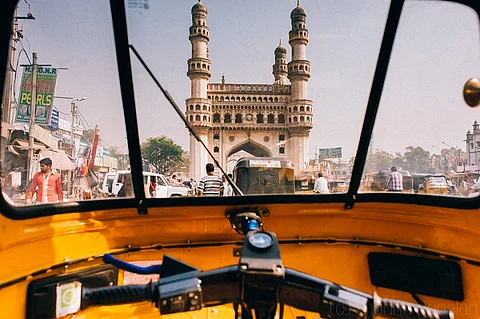

Hyderabad is a rapidly growing metropolis today, but at its heart, it is a quaint old town steeped in history, and owes its existence to the Qutb Shahi dynasty. Any discussion about the birth of Hyderabad has to begin at the Golconda Fort, perched on a hillock overlooking the city. It was built in the 11th century by the Kakatiya dynasty of Warangal, and at the time, it was just a simple mud fort. About 300 years later, the region briefly became a part the Delhi Sultanate. But soon, a commander named Alauddin Hassan Bahman Shah declared independence from the Sultanate, and founded the Bahmani Sultanate, with its capital in Bidar. This was the first Muslim kingdom in the Deccan. About two centuries later, the kingdom splintered into the five Deccan Sultanates of Ahmednagar, Berar, Bijapur, Bidar and Golconda. The first ruler of Golconda was Sultan Quli Qutb-ul-Mulk, who came to Bidar all the way from Iran, and quickly rose through the ranks of the Bahmani court from a courtier to the governor of the Golconda province.

The majestic Golconda Fort
Sultan Quli and seven of his successors ruled Golconda for nearly 175 years. Most of them kept making improvements to the simple fort, transforming it over time into a formidable, impregnable citadel. Under their patronage, art, architecture, literature, poetry, music and dance flourished, and Hyderabad’s treasured Ganga Jamuni tehzeeb began to take shape with the synthesis of Hindu and Muslim traditions.
The fifth ruler, Sultan Muhammad Quli Qutb Shah, is considered the greatest of them all. As a young man, he fell in love with Bhagmati, a Hindu girl from the village of Chichlam, to the south of the river Musi. As people from different parts of the world thronged to Golconda, a space crunch and outbreaks like cholera prompted the Sultan to establish a brand new city. The site he chose was around Chichlam, and the city, was none other than Hyderabad, named after Hyder Mahal, Bhagmati’s title. Some historians think the Bhagmati angle is only a legend, but it makes for a romantic story nevertheless, that generations of Hyderabadis have grown up hearing.

The ruins of the Golconda Fort
Most of Hyderabad’s famous structures date back to the Qutb Shahi era. The Hussain Sagar lake, for example, was built during the reign of the fourth Sultan Ibrahim Qutb Shah. The first structure to be built by Sultan Muhammad Quli Qutb Shah in his brand new city, continues to be its most famous - the Charminar. A little to the north of this edifice, is a fountain called Gulzar Hauz, at the intersection of four roads in the four cardinal directions. All the four roads have huge arches or kamans, about a 100 yards from the central fountain. They are together called the Charkaman.

Charminar, Hyderabad’s pièce de résistance
The Jama Masjid, next to the Charminar, is very hard to spot amidst the traffic and clutter of the area today, but it was the first mosque to be built in the new city. The stunning Badshahi Ashurkhana, where devotees mourn during Muharram, was built about a kilometer away. The imposing Mecca Masjid close to the Charminar was started during the reign of the sixth ruler Sultan Muhammad Qutb Shah, but was only completed much later, after the fall of the dynasty.

The Badshahi Ashurkhana
While these are the famous ones, Hyderabad's landscape is peppered with less known Qutb Shahi contributions too. The sublime Toli Masjid, the huge Kulsumpura Masjid named after a princess, the Miya Mishk Masjid built by an Abyssinian guard in the Golconda army, and many crumbling mosques and tombs dot the historic Karwan neighborhood. Driving towards the Gandipet reservoir will take one to Taramati Baradari where Sultan Ibrahim Qutb Shah's favourite dancer lived, and the Premamati mosque, also rumored to be named after a dancer. The Hayatnagar, Shaikpet and Karwan neighborhoods have sarais, where weary travelers could stop to rest.

Miya Mishka Masjid

Taramati Baradari
The last Qutb Shahi ruler was Sultan Abul Hassan Tana Shah. In 1687, Mughal emperor Aurangzeb turned up with his army in Golconda. After an eight month long siege, a traitor opened the Fateh Darwaza of the fort, and let the enemy in. Tana Shah was taken away and imprisoned in the Daulatabad fort, where he died more than a decade later. The kingdom was under Mughal occupation for a while, until the rise of the Asaf Jahi dynasty, or the Nizams, who ruled over the princely state of Hyderabad.
All the rulers of the Qutb Shahi dynasty except the last Sultan, are buried in a sprawling garden near the fort, along with their family members. Tana Shah was laid to rest in a modest grave in Daulatabad, where he died alone.

The Qutb Shahi Tombs

The garden in which the Sultans and their family members are buried